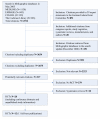Negative pressure wound therapy: potential publication bias caused by lack of access to unpublished study results data
- PMID: 18267008
- PMCID: PMC2291064
- DOI: 10.1186/1471-2288-8-4
Negative pressure wound therapy: potential publication bias caused by lack of access to unpublished study results data
Abstract
Background: Negative pressure wound therapy (NPWT) is widely applied, although the evidence base is weak. Previous reviews on medical interventions have shown that conclusions based on published data alone may no longer hold after consideration of unpublished data. The main objective of this study was to identify unpublished randomised controlled trials (RCTs) on NPWT within the framework of a systematic review.
Methods: RCTs comparing NPWT with conventional wound therapy were identified using MEDLINE, EMBASE, CINAHL and The Cochrane Library. Every database was searched from inception to May 2005. The search was updated in December 2006. Reference lists of original articles and systematic reviews, as well as congress proceedings and online trial registers, were screened for clues to unpublished RCTs. Manufacturers of NPWT devices and authors of conference abstracts were contacted and asked to provide study information. Trials were considered nonrandomised if concealment of allocation to treatment groups was classified as "inadequate". The study status was classified as "completed", "discontinued", "ongoing" or "unclear". The publication status of completed or discontinued RCTs was classified as "published" if a full-text paper on final study results (completed trials) or interim results (discontinued trials) was available, and "unpublished" if this was not the case. The type of sponsorship was also noted for all trials.
Results: A total of 28 RCTs referring to at least 2755 planned or analysed patients met the inclusion criteria: 13 RCTs had been completed, 6 had been discontinued, 6 were ongoing, and the status of 3 RCTs was unclear. Full-text papers were available on 30% of patients in the 19 completed or discontinued RCTs (495 analysed patients in 10 published RCTs vs. 1154 planned patients in 9 unpublished RCTs). Most information about conference abstracts and unpublished study information referring to trials that were unpublished at the time these documents were generated was obtained from the manufacturer Kinetic Concepts Inc. (KCI) (19 RCTs), followed by The Cochrane Library (18) and a systematic review (15). We were able to obtain some information on the methods of unpublished RCTs, but results data were either not available or requests for results data were not answered; the results of unpublished RCTs could therefore not be considered in the review. One manufacturer, KCI, sponsored the majority of RCTs (19/28; 68%). The sponsorship of the remaining trials was unclear.
Conclusion: Multi-source comprehensive searches identify unpublished RCTs. However, lack of access to unpublished study results data raises doubts about the completeness of the evidence base on NPWT.
Figures
References
-
- Kaltenthaler E, Whitfield MD, Walters SJ, Akehurst RL, Paisley S. UK, USA and Canada: how do their pressure ulcer prevalence and incidence data compare? J Wound Care. 2001;10:530–535. - PubMed
Publication types
MeSH terms
LinkOut - more resources
Full Text Sources
Medical
Miscellaneous


